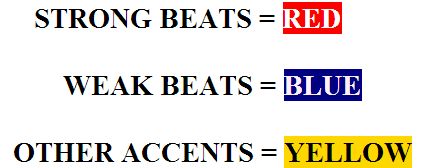BEAT EMPHASIS — BEAT ACCENT

To accent means to bring attention to the importance of something.
Certain beats are more prominent in rhythmic patterns and are accented.
Musical accent refers to the stress on certain beats within a measure. These accented beats have more intensity and are called strong beats.
Beat-Patterns have different accents and contain strongand weak beats. The most common beat-patterns have evolved from centuries of dance-beat patterns as well as from rhythmic patterns in poetry structures.
When placing your foot down to begin a dance step, it creates a strong first beat. The first beat of a measure receives a strongest accent and is called the Down-Beat.
Conductors outline beat patterns with their baton in order to lead the orchestra. The first beat of the measure is gestured with a down motion. This is similar to putting the foot down on the first beat of dance patterns, and why the first beat is called the Down-Beat.
Learning different conducting patterns helps you learn how to “get the feel” of beat-patterns.
As your Quest Maestro, I will be teaching you the baton motions that conductors use to communicate beat-patterns and their emphases to the orchestra.
I will utilize primary colors to define beat emphasis in order to bring attention to strong beats and weak beats.

Meet Cal
Universal Language
Rhythm Notation
Music Staff
Origins of the Staff
Rhythm Laboratory
Notation Parts
Note Heads
Stems
Beams
Flags
Note Construction
Common-Time
Measures
Bar-Lines
Counting in Common-Time
Whole, Half and Quarter Notes
Ties
Dots
Time-Signatures
Q’s Rhythm Review
Time-Signature Rules
Beat Accent
Down-Beat and Up-Beat
Conducting Patterns
Cut-Time
Common-Time Beat Emphasis
Three-Beat Measures
Note Values
Rhythm Workouts
The ‘Cycle’
Note Equivalents
Counting Sub-Divisions
“If You Can Say It, You Can Play It” Author’s Story
Sub-Division Lingo
Quarter Notes with Eight Notes
Adding Sixteenth Notes
Notes Sharing Beams
Beam Awareness Pointers
Triplets
Triplet Workout
Compound-Time
Compound-Time Workout
Music Rests
Rest and Note Equivalents
Whole Rest Half Rest
Quarter Rest Eighth Rest
Sixteenth Rest Dotted Rests
Q’s Rest Review
Process of Sub-Division
Relating Rests to Notes
Rhythm Exam Prep
Level 1 Rhythm Exam
Level 2 Rhythm Exam
Level 3 Rhythm Exam


